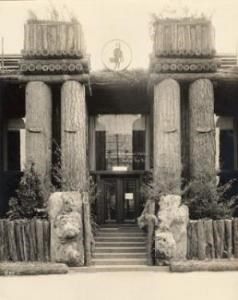
SFPL The month of March began with several days of clear skies, under which occurred several state and foreign buildings dedications, San Luis Obispo and Santa Clara Days, and the dedication of the House of the Hoo Hoo, on March 5th. The Concatenated Order of the Hoo Hoo is a fraternal organization of persons involved in the forest products industry. It was founded in Arkansas in 1892. The House was designed by Bernard Maybeck and represented the Hoo Hoo well. It was made all from wood and was located behind the Palace of Horticulture. The dedication embodied the Order’s mission to promote the well-being of its members and appeared as a campfire frolic more than an official ceremony. F.A. Trower, the Past Snark of the Universe (an official title granted to the head of the order), presided over the proceedings. 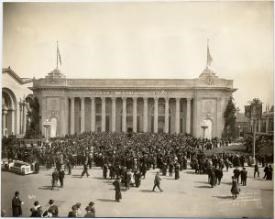
SFPL March 6th was a big day for racing, as the Vanderbuilt Cup and the motor boat race were both held. Master Painters and Decorators day celebrated the many artisans responsible for the Exposition’s appearance while the 80 piece Exposition Orchestra wrapped up the week’s festivities with their first performance, on Sunday March 7th. The next week opened under clear skies, with building dedications and Mendocino Day. Rain rolled in the next day and dampened Lake and Napa Counties Day, before giving way for the Southern Pacific Building Dedication on March 10th. The dedication of this building was the first for any corporation at the Expo. This honor seemed only appropriate as the Southern Pacific Company was the first corporation to purchase a large subscription ($250,000) towards the Exposition. They further contributed by using their extensive influence to spur investment from other persons and companies. Eager to acknowledge as many of the counties as possible in the early going, the next few days observed Marin, Kern and Tulare counties. March 12th was Salmon Day and was held at the Washington State Building, where 5,000 cans of tuna were handed out to eager fair-goers, by women in mermaid costumes. The National Parks Superintendents’ Association ended their three day convention at the Exposition on March 13th, which was celebrated as National Parks Day. The new plan for the parks was to bring them “closer to the people” by increasing ease of access. Unfortunately, the week ended in sorrow, as Lincoln Beachey flew his final flight on Sunday the 14th. Under cloudy skies, his flying machine plunged into the bay waters where he was submerged and drowned. Pacific Service Day was celebrated on March 15th. This day was for the employees and families of the Pacific Gas and Electric Company. They marched through the expo five thousand strong. The company was thanked for their tremendous support, both financially and not. The expo worked closely with the company to plan out the lighting and get the maximum benefit and minimum cost. The entire exposition was lit by electricity carried from the Sierra to the Bay by California’s own PG&E. The Polo tournament began on March 16th. That same day, the Young Men’s Christian Association was recognized. 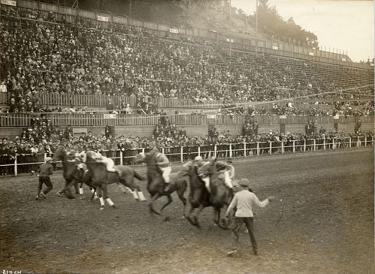
SFPL Saint Patrick’s Day began, beneath cloudy skies, with morning mass at Saint Mary’s Cathedral- followed by a procession to the Exposition’s Festival Hall. Such was the turn-out, the Festival Hall could not accommodate all whom wanted to observe the ceremony. Irish songs were song and many speeches were given. The Exposition Grounds and streets surrounding it were filled with folks wearing green and shamrocks. Some very popular events of the day were the horse shows and competitions of all kinds. The Expo Race Track hosted many categories: ponies, three-gaited and five-gaited saddle horses, carriage horses, chargers, trotters, a mile race, high jump and ladies’ jumping. 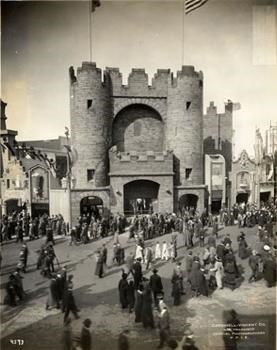
SFPL The St. Patrick’s Day Games included the 100 yard and 220 yard dash, the quarter mile, the mile, shot put, high and long jump. There was Irish Hurling, while teams from Oakland and San Francisco contested a Gaelic football match on the Marina. The day concluded with a lovely night. The many lights of the exposition, including the scintillator, were changed to emerald green, “…the whole exposition, towers, facades, sculptures, domes, fountains, colonnades, turned by lamps and screened searchlights to soft, shimmering emerald, as tender a green as any the Atlantic mists ever grew on the Irish coast.” (Todd, 1920) While Ireland did not receive a pavilion, The Shamrock Isle, which was housed in The Zone, was to be a display of Irish life and contributions. However, due to the war in Europe, it was difficult to obtain much to furnish the exhibit. The Irish dancing and singing shows were not enough to draw significant financial rewards and the Isle was eventually converted to the Streets of All Nations. It then enjoyed some moderate success, but lost any of the relation to Ireland which had once been intended. On March 18th, Festival Hall hosted a simple Dedication Ceremony to the Atchison, Topeka and Santa Fe Railroad’s Contribution, the Grand Canyon of Arizona, which was located in The Zone Amusement and Concession area. It consisted of a scale replica Grand Canyon, a Hopi Village where one could purchase blankets and the Daughters of the American Revolution held headquarters in front. The concession did good business but the profit was diminished due to the $90,000 required to construct it. Resting behind the Great Tower of Jewels, at the center of the exposition, the Court of the Universe was the site of possibly the most important dedication ceremony of the entire exposition. Travertine Day was dedicated to the man that introduced the building material with which the entire expo was formed. Previous expos had used plaster to simulate marble in the buildings, which created an unnatural appearance. Travertine is a form of limestone that has been used in construction for centuries. The coliseum is constructed mostly of Travertine. With artificial travertine-having been invented a few years earlier-at their disposal, the exposition builders were able to create a realistic appearance as though the buildings had existed there for ages. It was thanks to Paul E. Denivelle, of the New York firm McKim, Mead and White whom suggested its use and to whom this day was dedicated. March 19th was a very full day. The New York Building was dedicated. Chamber of Commerce Day was celebrated, as well. Great appreciation was hefted upon those many men whom had made the idea of the Exposition into a reality, by finance or other means. That same day was the beginning of the Spring Flower Show. With support from the Pacific Coast Horticulture Society and in conjunction with the Department of Horticulture of the Exposition, the Palace of Horticulture hosted the three-day show that included tulips, hyacinths, daffodils, and hydrangeas. The first day was dedicated to flowers of general interest, the second day was dedicated to table decorations of cut flowers, and the third day ended with bridal bouquets. March 20th hosted the Citrus Protective League’s Orange Day, Stanford University Day and California Legislature Day. The Exposition achieved a great feat this day-the highest attendance of any expo in the first thirty days, over 2,000,000 people. The Vice President of the United States Thomas R. Marshall arrived on the 20thin anticipation of the Exposition Dedication on the 24th. 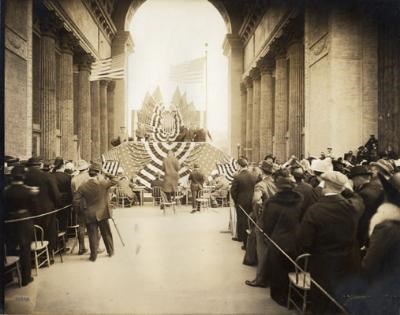
SFPL While the President of the United States, Woodrow Wilson had expressed desire to visit the Exposition, international issues, including World War I, kept him away. In Wilson’s place was the Vice-President Thomas R. Marshall. Marshall was accompanied by a large group, which included Assistant Secretary of the Navy and member of the Exposition Commission, Franklin D. Roosevelt. The ceremonies began at 2 o’clock after a luncheon given to the Vice-President by the President and Directors of the Exposition. The parade procession that led up to the speech consisted of over 3,000 men, including the bands from the flagship “Colorado” and the cruiser “Maryland.” At the base of the Tower of Jewels, Vice-President Marshall delivered a speech. The crowd applauded before and after, but not during. They dispersed as if strongly affected by the words. The day concluded with a ball given in honor of the Vice-President of the United States. Following the impressive dedication display of the 24th, the rest of the month seemed to fly by, as rain came down for the next five days. Among the remaining festivities were: Live Stock Association Day, Real Estate Day, Canadian Pacific Railroad Building Dedication, California Poppy Day and Ripe Olive Day. Sacramento, Yolo, Colusa, Glenn and Butte Counties were also celebrated. Continue on to visit April of the Exposition Year Return to February at the Exposition Return to the Panama-Pacific International Exposition |
Last updated: July 1, 2015
